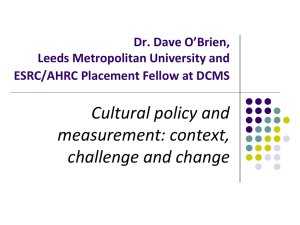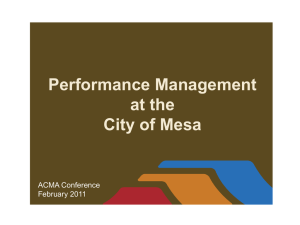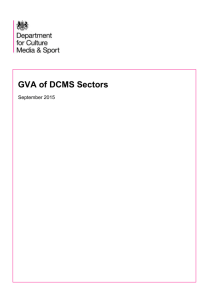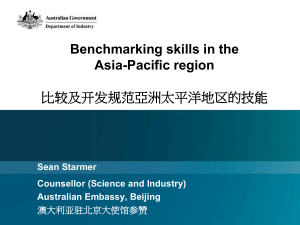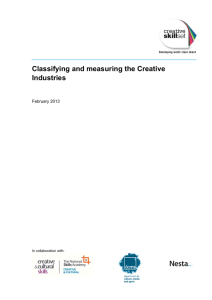Classifying and measuring the creative industries
advertisement
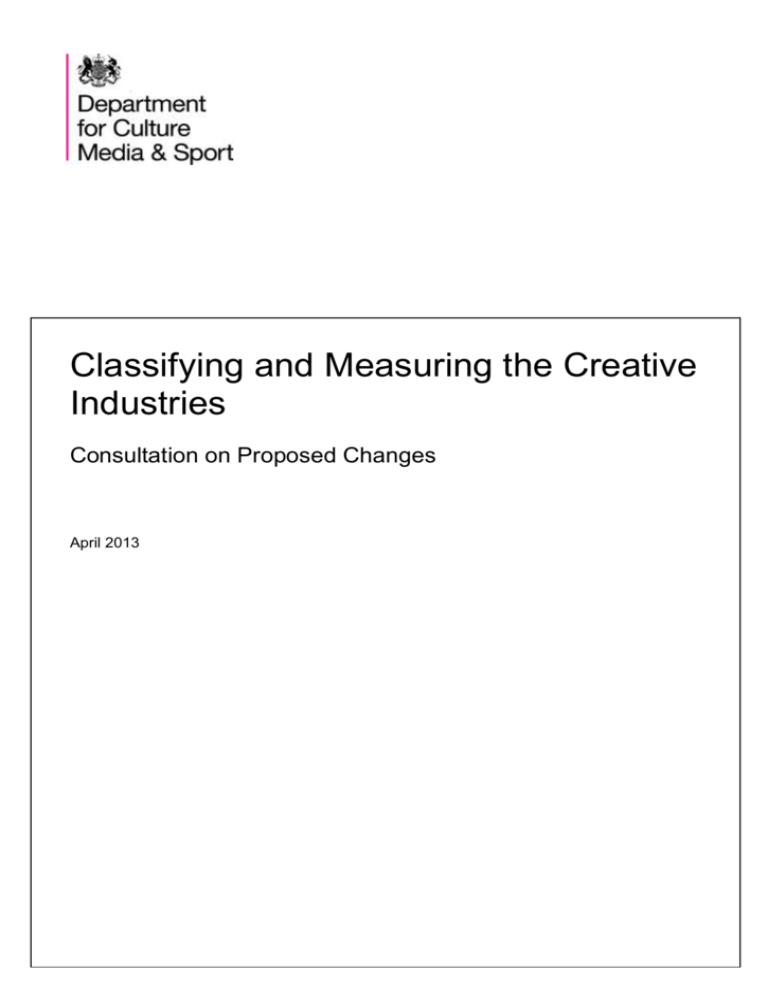
Classifying and Measuring the Creative Industries Consultation on Proposed Changes April 2013 Department for Culture, Media & Sport Classifying and Measuring the Creative Industries Department for Culture, Media & Sport Classifying and Measuring the Creative Industries 3 Contents Chapter 1: Introduction .............................................................................. 4 Chapter 2: Reasons for change ................................................................. 6 Chapter 3: Quality commitment ................................................................. 7 Chapter 4: Proposal ................................................................................... 8 Chapter 5: Timing .................................................................................... 19 Chapter 6: How can I respond? ............................................................... 20 4 Department for Culture, Media & Sport Classifying and Measuring the Creative Industries Chapter 1: Introduction The purpose of this consultation is to update the DCMS Creative Industries classification and we are inviting input from interested parties. We have been engaging with industry and partner organisations over potential changes via a Technical Working Group of the Creative Industries Council and are now at a point where we would like to go out to consultation and seek wider views. We have been working with partners (NESTA, Creative Skillset and Creative and Cultural Skills), to review and update the classification used in the DCMS Creative Industries Economic Estimates (CIEE). We intend to use this review “Classifying and Measuring the Creative Industries”, referenced below, as an objective starting point to suggest which occupations and industries should be included in the updated DCMS classification. The review uses the idea of “creative intensity” (the proportion of people doing creative jobs within each industry) to suggest which industries should be included. If the proportion of people doing creative jobs in a particular industry is substantial, above a 30% threshold, the industries are candidates for inclusion within the Creative Industries classification. Similar to the outlook in our current Creative Industries Economic Estimates, the “creative intensity” approach focuses on industries where the creative activity happens. The intention is to produce a classification which provides direct estimates of employment and the contribution to the economy, with no double counting – rather than attempting to capture all activity further down the value chain, for example, retail activities. The classification generated in this way can be used as a starting point for indirect estimates which include wider economic effects along the supply chain. Any approach has data and methods constraints, which may affect some industries more than others. These limitations are reflected in the consultation and consultees are invited to suggest alternatives, supported by evidence-based argument. Weaknesses in the underlying classifications and data used to construct these estimates, which are identified by users, will be fed-back to the organisations which set these standards and provide these data so that we can influence longer-term improvements. The latest DCMS Creative Industries Economic Estimates are linked below: https://www.gov.uk/government/publications/creative-industries-economic-estimatesdecember-2011 Department for Culture, Media & Sport Classifying and Measuring the Creative Industries 5 This document is the main consultation paper, but there are also two further research papers which inform the consultation process. These are: • Classifying and Measuring the Creative Industries, a collaborative project led by Creative Skillset, partnered by Creative and Cultural Skills and involving the DCMS and NESTA. This can be accessed at: http://www.creativeskillset.org/research/activity/classifications/article_9067_1.asp . It should be noted that the proposals for classifying and measuring the Creative Industries are based on the classifications contained in this report. Taking this review as a starting point, the consultation seeks wider input that the classification it suggests forms a coherent set of creative industries and occupations that is useful to policymakers, industry, academics and other users of the statistics; A Dynamic Mapping of the UK’s Creative Industry, a NESTA publication by Hasan Bakhshi, Alan Freeman and Peter Higgs, which is available at: http://www.nesta.org.uk/areas_of_work/creative_economy/assets/features/a_dynamic_ mapping_of_the_uks_creative_industries. This report supports the use of the “Creative Intensities” approach and its findings are broadly consistent with the report above 1. Throughout this document we will be referring to: The Standard Industrial Classification, a means of classifying businesses according to the type of economic activity that they are engaged in. The latest version (SIC 2007) is available here: http://www.ons.gov.uk/ons/guide-method/classifications/currentstandard-classifications/standard-industrial-classification/index.html The Standard Occupational Classification, a means of classifying the occupation of a person according to the work they do and the skill level required. The latest version (SOC 2010) is available here: http://www.ons.gov.uk/ons/guidemethod/classifications/current-standard-classifications/soc2010/index.html The consultation will be open for 8 weeks, closing at midnight on 14th June, 2013. A separate response form has been provided for feedback on the consultation issues set out below. Please submit this together with any other supporting evidence to: statsconsultation@culture.gsi.gov.uk If you have any questions, please contact: statsconsultation@culture.gsi.gov.uk or Tom Knight Department for Culture, Media and Sport Phone: 0207 211 6021 1 The main differences in the classifications suggested by the two reports is that the NESTA report uses the 2000 SOC classification (so that its findings would be comparable to the earlier DCMS estimates) whilst the Creative Skillset report uses the updated SOC 2010 classification. 6 Department for Culture, Media & Sport Classifying and Measuring the Creative Industries Chapter 2: Reasons for change The current classification system used by DCMS has been in existence for a considerable period of time – since the first estimates were produced in 1998. It has a substantial and positive reputation and has been replicated in many countries around the world. However, increasingly attention is being paid to inconsistencies in the DCMS methodologies which have emerged with the passage of time, which relate to (i) the areas of industrial activity which are included and (ii) the use of SIC codes to capture the data. These issues are discussed at length in the Creative Skillset and NESTA papers referenced above. Due to the emergence of these inconsistencies over time, it has been argued that a more robust method of classifying and defining the Creative Industries using “Creative Intensities” should be used. In essence, a Creative Industry is defined as being one which employs a significant proportion of creative people, i.e. those employed in a creative occupation. To simplify the classification and to enable it to be replicated and built on by other users we are proposing to no longer use proportions (which were based on secondary data) to breakdown data at the lowest level of industrial or occupational classification available even further. Industries and occupations are considered to be either in or out of the proposed classification. We are also proposing that we move to a 4-digit rather than 5-digit based classification; this should enable better comparability across data sources and enable better international comparisons. Department for Culture, Media & Sport Classifying and Measuring the Creative Industries 7 Chapter 3: Quality commitment The DCMS Creative Industries Economic Estimates are a key output, providing a reliable evidence base for many people who develop policy for, champion or work within the Creative Industries, a key sector of the UK economy. The series began as a result of development work on official data sources following a commitment in the 2001 Creative Industries Mapping Document. This commitment will be maintained. DCMS intends to produce a range of data covering the same issues as in the current estimates, namely: • Gross Value Added – the amount that the creative industries (and its component sectors) contribute to the economy; • Export of services; • Employment, including employees and self-employed people working (i) in Creative Industries in both creative and non-creative roles and (ii) in Creative occupations not within the Creative Industries; and • Numbers of businesses. Whilst it is clear that the adoption of a new methodology would render comparisons between the new estimates and those produced from previous reports as invalid, we intend to calculate data for earlier years in line with the new classification. We will also explore the feasibility of producing backcast data based on the new SOC 2010 classification. We believe that the changes proposed will make the estimates a more accurate representation of the current UK Creative Industries. 8 Department for Culture, Media & Sport Classifying and Measuring the Creative Industries Chapter 4: Proposal 4.1 Overall approach The proposal is that the DCMS adopts a different approach to classifying the creative industries – that of calculation of Creative Intensities, which is done by: 1. identifying creative occupations; 2. measuring employment in these creative occupations in each sector to identify those that can be classified as creative industries; and 3. once we have identified the relevant sectors by the use of Creative Intensities, we group these SIC sectors into broad Creative Industry groups. We can then add the employment levels of creative occupational employment lying outside the creative industries to calculate the numbers employed in Creative Occupations employed outside the defined Creative Industries to re-create the previous DCMS estimates. This approach has a considerable track record, which is both used and described in detail in the recent Creative Skillset and NESTA publications. The NESTA publication, for example, contains a comprehensive sensitivity analysis of the creative intensity methodology and concludes that it is robust. However, this approach is not without issues: • those industries that do not have significant support structures (eg administrative staff) or physical presence (eg buildings to maintain) may be more likely to have a higher concentration of creative people. This may therefore bias the model slightly towards businesses and sectors with newer business models and methods of working eg outsourced administration, digital rather than physical products, etc; and • this approach is completely located within the current classification systems used – the Standard Industrial Classification (SIC) and the Standard occupational Classification (SOC). To the extent that these classification systems do not fully capture creative Department for Culture, Media & Sport Classifying and Measuring the Creative Industries 9 economic activity, any definition that is based solely on the use of these classification systems will also not do so. The approach has the merit of being simple and transparent and uses as its data source employment levels. We are not proposing to move to a definition system which includes use of data on Intellectual Property (IP), including copyright, patents and trademarks. Whilst noting the importance of the role of IP in generating value for creative businesses, we do not think that it is sufficiently common across all the Creative industries to make it the central element of the definition process. At this stage, the proposals we have made below are based on the data – it is a datainformed approach in that we are using the method of Creative Intensities as the evidence base. However, these data are not the only basis on which decisions can and should be made. We want to agree a coherent set of industries which stakeholders find useful: we are open to other evidence as appropriate. This is discussed at various points below. Consultation issue 1: what are your views of using the Creative Intensities methodology to underpin the DCMS Creative Industries classification? Each of the three stages is discussed in more detail below. 4.2 Defining creative occupations The first stage, and the foundation stage, of the process is to decide which are the creative occupations. This is not a new concept – the current DCMS creative industry estimates explicitly estimate levels of employment in creative occupations, for which a list of creative occupations is used. However, it should be noted that the selection of creative occupations is a matter for professional judgement, based on what is known about the occupational group in question, allied to the definition of that occupation in the SOC classification. It is not a data-based analysis2. The occupations we propose as being Creative Occupations are shown in the table below. The rationale between the choice of these occupations is given in detail in the Creative Skillset paper. The set is essentially an updated set of the most recent DCMS creative occupations – updated to take account of the recent occupational classification change from SOC 2000 to 2 Although the NESTA report does set out a transparent framework within which this professional judgement of creativity can be brought to bear on the different occupations in the economy 10 Department for Culture, Media & Sport Classifying and Measuring the Creative Industries SOC 2010. The new classification allows a much better definition in the areas of digital and IT occupations and introduces a number of new IT categories. It is coherent with the NESTA set of Creative Occupations which uses SOC 2000. It should be noted that these are defined using the SOC 2010 classification 3 and we are defining these at a ‘4-digit’ level. We have shown estimated employment sizes in order that readers can see the relative ‘importance’ of each occupational group. Figure 1: Proposed list of creative occupations Code 1132 1134 1136 2135 2136 2137 2431 2432 2435 2451 2452 2471 2472 2473 3121 3411 3412 3413 3414 3415 3416 3417 3421 3422 3543 Description Marketing and sales directors Advertising and Public Relations Directors Information technology and telecommunications directors IT business analysts, architects and systems designers Programmers and software development professionals Web design and development professionals Architects Town planners Chartered architectural technologists Librarians Archivists & curators Journalists, Newspaper and Periodical editors Public relations professionals Advertising accounts managers and creative directors Architectural and town planning technicians Artists Authors, writers and translators Actors, entertainers and presenters Dancers and choreographers Musicians Arts officers, producers and directors Photographers, audio-visual and broadcasting equipment operators Graphic Designers Product, Clothing and related designers Marketing associate professionals Total Creative SOC employment Employment (000s) % 181 12.2 19 1.2 54 3.7 89 6.0 224 15.1 60 4.0 46 3.1 16 1.1 4 0.3 26 1.8 11 0.7 64 4.3 38 2.6 26 1.8 18 1.2 39 2.6 73 4.9 37 2.5 17 1.2 37 2.5 66 4.4 71 4.8 67 4.5 54 3.6 150 10.1 100.0 1,487 5.1 Source: Labour Force Survey, March 2011 – April 2012 averaged 3 The Standard Occupational Classification (SOC) is a means of classifying the occupation of a person according to the work they do. It provides a framework within which data can be collected and analysed. The SOC system has four levels of detail, firstly at a very broad 1 digit level and then down in increasingly more detail to the lowest level available – the 4-digit level. Department for Culture, Media & Sport Classifying and Measuring the Creative Industries 11 Consultation issue 2: what are your views of the list of Creative Occupations as defined above? Are there occupations which have been included which you think should not be? Are there occupations which have not been included which you think should be? What evidence do you have (if any) to support your view on inclusions or exclusions? Please note: we can only consider occupations for the list above if they are stated in terms of the Standard Occupational Classification system. If more information is needed on this classification system, it can be found at: http://www.ons.gov.uk/ons/guidemethod/classifications/current-standard-classifications/soc2010/index.html 4.3 Identifying creative Standard Industrial Classification groups We propose including those sectors as Creative Industries which: • exceed a threshold of 30 per cent Creative Occupational employment: the choice of this threshold is discussed at considerable length in the NESTA and Creative Skillset research papers, but (in summary) is one that analysis suggested was the optimal threshold level and provides good separation between creative and non-creative industries; and • exceed a minimum size limit of employment within a sector of 10,000, because below this level the Labour Force Survey data becomes more variable and is not as reliable. Any sector which has less than this as its total employment level is not included4. Based on this, the proposed list of Creative Industries are as shown in Figure 2 below. 4 Where a 4 digit SIC would have been excluded on this basis, but when it meets the threshold criteria and forms part of a more aggregated 3-digit SIC codes which also meet the threshold criteria we have amended the size exclusion ruling to be that 4 digit sectors which have less than 10,000 employment should be excluded, except where they form part of a 3 digit sector which would otherwise all be included 12 Department for Culture, Media & Sport Classifying and Measuring the Creative Industries Figure 2: Proposed list of Creative Industries SIC Code Description 58.1 Publishing of books, periodicals and other publishing activities, to include 58.11 Book publishing 58.12 Publishing of directories and mailing lists 58.13 Publishing of newspapers 58.14 Publishing of journals & periodicals 58.19 Other publishing activities Software publishing, to include 58.21 Publishing of computer games 58.29 Other software publishing Motion picture, video and television programme activities, to include 59.11 Motion picture, video & TV programme production activities 59.12 Motion picture, video & TV programme postproduction activities 59.13 Motion picture, video & TV programme distribution activities 59.14 Motion picture projection activities Sound recording & music publishing activities Programming and broadcasting activities, to include 58.2 59.1 59.2 60 62.01 62.02 70.21 71.11 73.1 74.1 74.2 74.30 85.52 90.0 60.1 Radio broadcasting 60.2 TV programming & broadcasting activities Computer programming activities Computer consultancy activities PR & communication activities Architectural activities Advertising, to include 73.11 Advertising agencies 73.12 Media representation Specialised design activities Photographic activities Translation and interpretation activities Cultural education Creative, arts and entertainment activities, to include 90.01 Performing arts 90.02 Support activities to performing arts 90.03 Artistic creation 90.04 Operation of arts facilities All Sector (000s) 177 Employment Creative (000s) 91 % creative 51.3 18 8 42.9 98 55 56.6 13 60 5 34 43.1 57.4 215 255 22 99 123 118 80 14 62 56 54.9 31.4 63.3 63.0 45.5 103 47 20 28 140 61 35 16 12 101 59.0 73.9 83.6 43.9 72.5 1,415 749 52.9 Source: Labour Force Survey, March 2011 – April 2012 Consultation issue 3: what are your views of the list of sectors as defined above? Are there sectors which have been included which you think should not be? Are there sectors which have not been included which you think should be? What evidence do you have (if any) to support your view on inclusions or exclusions? Please note: we can only consider occupations for the list above if they are stated in terms of the Standard Industrial Classification system. If more information is needed on this classification system, it can be found at: http://www.ons.gov.uk/ons/guidemethod/classifications/current-standard-classifications/standard-industrialclassification/index.html Department for Culture, Media & Sport Classifying and Measuring the Creative Industries 4.4 13 Creating broad industry groups The use of a SIC code listing is not the most accessible listing and are not always a useful communication tool. So, we propose organising these SIC codes into ‘groups’ which are recognisable to the wider user. These will be comparable to the ‘sectors’ in the original DCMS estimates. We are proposing the industry groups as shown in Figure 3 below. On this basis we have groups for Advertising and marketing, Architecture, Design and designer fashion, Film, TV, video and radio, IT, software and computer services, Publishing, and Music, performing and visual arts. We are aware that some of these groupings will not suit some needs, and that there are some ‘groups’ which are not identified in this list – such as Music or Computer games. However, we are restricted to the ‘building blocks’ of the SIC codes and these suggested below are those which seem feasible without splitting SIC codes, by taking a proportion of them, or moving to a system which uses 5-digit SICs5. Figure 3: Broad creative industry groups Broad SIC sectors codes Advertising and marketing 70.21 PR & communication activities 73.1 Advertising Architecture 71.11 Architectural activities Design and designer fashion 74.10 Specialised design activities Film, TV, video, radio and photography 59.1 Motion picture, video and television programme activities 60 Programming & broadcasting activities 74.20 Photographic activities IT, software and computer services 62.01 Computer programming activities 62.02 Computer consultancy activities Publishing 58.1 Publishing activities 58.2 Software publishing 74.3 Translation and interpretation services Music, performing and visual arts 59.20 Sound recording & music publishing activities 85.52 Cultural education 90.01 Performing arts 90.02 Support activities to performing arts 90.03 Artistic creation 90.04 Operation of arts facilities N (000s) 144 10.2 99 7.0 103 7.3 205 14.5 470 33.2 214 15.1 182 12.8 All 1,415 100 Source: Labour Force Survey, March 2011 – April 2012 5 For which data availability is very limited. % 14 Department for Culture, Media & Sport Classifying and Measuring the Creative Industries Consultation issue 4: what are your views of the list of groupings as shown above? Are there other groupings which you think would be preferable, given the SIC codes available to match together in these groupings? 4.5 Differences between the proposed classification and the current DCMS classification In terms of comparisons with the broad sectors used in the DCMS estimates, the proposal reduces these from 13 to seven. The table below shows the comparison, but the main changes are: the removal of sectors for (i) Arts and antiques and (ii) Crafts; the conflation of some sectors to form one, namely (i) design and designer fashion into a single sector; (ii) Film and video and TV and radio into a single sector; and (iii) Interactive leisure software and Software and computer services into one. In reality the reduction is not as great as it seems – the DCMS estimates although listing 13 broad sector groups actually only measured 11 because the SIC codes could not support an identification and estimation of two of the groups. Arts and Antiques To note, artists themselves are captured in what we are proposing, “artistic creation” is included in the “Music, performing and visual arts” section. The creative intensity within the former “Arts and Antiques” group is low. The two industries, “Retail sale in commercial art galleries” and the “Retail sale of antiques” are primarily concerned with retail activity not creative activity. We recognise that there is some creative activity involved in curation and that people may visit galleries to view and consume art rather than to buy it. The former “Arts and Antiques” group used a small percentage of this retail employment to represent this creative activity – but this was not an ideal approach and for consistency we are keen that retail activities aren’t included in the Creative Industries estimates. Crafts Most crafts businesses are too small to identify in business survey data, so while there has been a crafts section in the former classification, we’ve not been able to provide GVA data. The removal of a number of craft roles from the latest update to the ONS occupational coding (removal of Goldsmiths, Silversmiths, Precious Stone workers, for example) into the more generic ‘Other skilled trades’ occupational group has made crafts even harder to Department for Culture, Media & Sport Classifying and Measuring the Creative Industries 15 identify. We6 believe that many crafts workers are very clearly in creative occupations. However, in the official classifications, many of these workers are spread across a range of occupational and industrial codes which contain vastly greater numbers of obviously noncreative workers. To include these codes would not give an accurate value to the crafts sector, so we are looking at better ways to measure this contribution. Designer Fashion It is a limitation of the underlying classifications in the source data that designer fashion can’t be separated out from other design activity. In the previous estimates, the solution was to count a very small proportion of retail fashion as “designer fashion” to capture the creative element – but this was seen as unsatisfactory and introduces retail into the classification which we want to avoid. Figure 4: Comparison between DCMS broad sectors and proposed broad sectors DCMS sectors Advertising Architecture Arts and antiques Crafts Design Designer fashion Film and video Television and radio Interactive leisure software Software and computer services Music Performing arts Proposed sectors Advertising and marketing Architecture None None Design and designer fashion Changes Widened to include marketing Same Not included in proposed classification Not included in proposed classification Conflated to form a single sector Film, TV, video, radio and photography IT, software and computer services Music, performing and visual arts Conflated to form a single sector Publishing Publishing Same Conflated to form a single sector Conflated to form a single sector and defined differently in terms of SIC codes The second comparison is to compare the SIC codes contained within the DCMS definition with those used in the proposed definition. This is shown below, but the main points are that: a number of SIC codes are removed from the estimates, mainly related to manufacture, printing and retail; a number of SIC codes are added which mainly relate to the IT industry (particularly the “Computer programming activities” and Computer consultancy sectors, which are of a significant employment size) and to cultural education; many SIC codes remain the same. We have amended this sentence which formerly read “We recognise that high-end craft occupations contain a creative element, but the view is that in the main, that these roles are more concerned with the manufacturing process, rather than the creative process.” this referred specifically to the representation of craft in the current official occupational coding, but, particularly when taken out of context, was causing concern that we were implying that craft is not creative, which was not the intention. 6 16 Department for Culture, Media & Sport Classifying and Measuring the Creative Industries Inclusion of relevant IT industries IT software and computer services form a readily identifiable industry group within the proposed classification and their contribution can be identified separately. The introduction of the new occupational classification (SOC2010) has enabled better identification of IT occupations which are creative (eg web design and programmers) from those which are not. The “creative intensity” approach leads to the introduction of a number of software and IT industries since the “digital creative” parts of these sectors can now be better identified. Adoption of the “creative intensity” approach provides a rationale for their inclusion and the current view supported by industry and partners is that these activities are vital to the Creative Industries. Further detail is provided on pages 14-16 in the supporting paper “Classifying and Measuring the Creative Industries” http://www.creativeskillset.org/research/activity/classifications/article_9067_1.asp . Figure 5: Comparison between DCMS broad sectors and proposed broad sectors Used in DCMS definition only (dropped) 14 Manufacture of wearing apparel 15.12 15.2 18.11 Manufacture of luggage, handbags, and the like, saddlery and harness Manufacture of footwear Printing of newspapers Used in both 58.1 58.2 59.1 59.2 18.13 Pre-press and premedia services 18.20 Reproduction of video recording Retail sale in commercial art galleries 71.11 Retail sale of antiques, including antique books, in stores News agency activities Motion picture, television and other theatrical casting 74.10 47.78/1 47.79/1 63.91 78.10/1 60 73.1 74.20 90.0 Publishing of books, periodicals and other publishing activities, to include book publishing, publishing of newspapers, publishing of journals and periodicals and other publishing activities Software publishing, to include publishing of computer games and other software publishing Motion picture, video and television programme activities Sound recording and music publishing activities Programming and broadcasting activities, to include Radio broadcasting and Television programming and broadcasting activities Architectural activities Advertising to include Advertising agencies and Media representation Specialised design activities Photographic activities Creative, arts and entertainment activities, to include Performing arts, Support activities to performing arts, Artistic creation and Operation of arts facilities Used in new proposal only (added) 62.01 Computer programming activities 62.02 Computer consultancy activities 70.21 PR & communication activities Translation and interpretation activities Cultural education 74.30 85.52 Department for Culture, Media & Sport Classifying and Measuring the Creative Industries 17 The proposed definition of Creative Industries gives an estimated total employment in the Creative industries of 1,415,000, to which we need to add the employment in creative occupations which lie outside the Creative Industries of 738,000. This gives a total of creative employment of 2,153,000. This estimate is considerably higher than the numbers generated by the DCMS in their last estimates. The main differences lie in the number of people employed within the creative industries. Whilst there is a higher number of people employed in creative occupations outside the creative industries (738,000 compared to 601,000), the bigger differences are in employment in the Creative Industries themselves (1,415,000 compared to 897,000). Figure 6: Comparison of proposed creative employment to DCMS creative estimates New estimate (000s) Creative employment within creative industries Non-creative employment within creative industries Total in creative industries Creative employment in non-creative industries Total creative 749 666 1,415 738 2,153 DCMS creative estimates (000s) 477 420 897 601 1,498 Source: Labour Force Survey, March 2011 – April 2012 4.6 Issues which arise because of the current SIC and SOC classifications The definition as created above is totally located within the constraints of the current classification systems ie the Standard Industrial Classification and the Standard Occupational Classification. To the extent that these fail to capture creative activity then the definition fails to describe the creative industries and the wider creative economy accurately. Examples are given in the Creative Skillset research paper. Whilst reviews of the SIC and SOC codes are not due for some time, a long term aim is to review these and make suggestions for how the Creative Industries should be treated in the future. We are seeking views therefore on how the current SIC and SOC describe ‘creative’ economic activity and, where there are thought to be shortcomings, how they could be better defined. It is worth noting that Creative Skillset and Creative and Cultural Skills are jointly sponsoring a scoping project specifically to look at this issue in detail. We would pass any responses that you might make to this project to inform that consultation. Creative Skillset and Creative and Cultural Skills will be contacting stakeholders separately on this issue. Consultation issue 5: do the SIC and SOC codes adequately and accurately capture the full range of economic activity within the creative industries. If not, how would you better define the SIC and SOC codes? 18 4.7 Department for Culture, Media & Sport Classifying and Measuring the Creative Industries Range of data to be collected As discussed in Section 3 above, we intend that the range of data to be collected will remain the same as for previous Economic Estimates, ie Gross Value Added, value of services exports, employment, and number of businesses. However, we would be interested in understanding whether (i) this range of statistics are those which are of most valuable to your organisation and, if not: • What other indicators you find to be of value; • Whether you collect data against these indicators on a regular basis; and • How you collect these data. Consultation issue 6: What indicators do you find to be of value in your work? Do you collect data against these indicators on a regular basis and, if so, how do you do so? Department for Culture, Media & Sport Classifying and Measuring the Creative Industries 19 Chapter 5: Timing This consultation will end at midnight on 14th June. We will analyse the results during June and July 2013 and post a summary and our response to the consultation in July on the DCMS website. We do not intend to enter into correspondence with individual respondents, but do commit to reading and considering all responses. We may make your responses available on request, unless you indicate that you wish your response to be kept confidential. 20 Department for Culture, Media & Sport Classifying and Measuring the Creative Industries Chapter 6: How can I respond? You can respond by providing your answers to the consultation issues above – we have provided a separate response document for you to do this. If you wish your response to be kept confidential you have the option to specify this at the end of the document. Responses should be sent to statsconsultation@culture.gsi.gov.uk . You will note, that at various points in this document we have asked for evidence. We are happy to accept any form of evidence, but that which is supported by robust forms of evidence will clearly be given greater weight than those which are purely anecdotal. For best practice, we recommend that you follow the Intellectual Property Office guide to standards for Good Evidence for Policy linked below: www.ipo.gov.uk/consult-2011-copyright-evidence.pdf 4th Floor, 100 Parliament Street London SW1A 2BQ www.gov.uk/dcms
